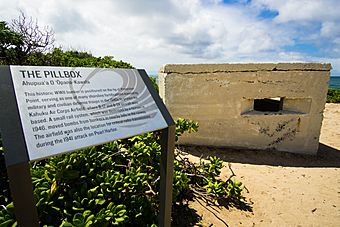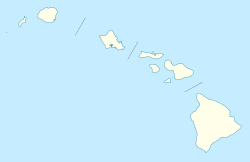Opana Radar Site facts for kids
|
Opana Radar Site
|
|
 |
|
| Location | Kawela Bay, Hawaii |
|---|---|
| Area | less than one acre |
| Built | 1941 |
| NRHP reference No. | 91001379 |
Quick facts for kids Significant dates |
|
| Added to NRHP | September 19, 1991 |
| Designated NHL | April 19, 1984 |
The Opana Radar Site is a special place in Hawaii that remembers an important moment in history. It's known as a National Historic Landmark and an IEEE Milestone. This site is where the United States first used radar during a war, specifically during the attack on Pearl Harbor. You can find it on the island of Oahu, near the north shore, not far from Kawela Bay. The site is not open to visitors.
How Radar Came to Opana
In December 1939, the U.S. military started something new called the Aircraft Warning Service (AWS). Their goal was to use radar to protect American land. They used a special radar called the SCR-270 radar. This was the first long-range search radar made in the United States. It was developed around 1937 in New Jersey. This radar could detect things up to 150 miles away. It could even see farther if it was placed on a high spot.
Under the command of Colonel Wilfred H. Tetley, the AWS set up six mobile radar sites on O'ahu. These sites were at Kawaiola, Wainaae, Ka'a'awa, Koko Head, Schofield Barracks, and Fort Shafter. On Thanksgiving Day in 1941, one of these radar sets was moved. It went from Schofield Barracks to the Opana Radar Site. This new spot was 532 feet above sea level. It had a clear view of the Pacific Ocean. The radar equipment was carried on four trucks. These trucks held the transmitter, receiver, and the large antenna.
The Day of the Pearl Harbor Attack
On December 7, 1941, Private Joseph L. Lockard and Private George Elliot were working at the Opana Radar Site. Their shift was supposed to end, but their ride to breakfast was late. So, they kept practicing with the radar equipment. At 7:02 am, they saw something unusual. The radar showed many planes approaching.
The two privates quickly reported what they saw. They called the temporary information center at Fort Shafter. Private Joseph McDonald took their call. McDonald then found Lieutenant Kermit Tyler to tell him the news. Tyler told McDonald that it was "nothing" to worry about. McDonald called Opana back and spoke to Private Lockard. Lockard was very excited because he had never seen so many planes on the radar. McDonald, feeling Lockard's excitement, went back to Tyler. He suggested Tyler call other plotters and tell Wheeler Field about the planes. But Tyler again said it was nothing. McDonald insisted that Tyler talk to Lockard directly. Most of the information center staff had gone to breakfast. Lieutenant Tyler thought the planes were a group of American B-17 Flying Fortress bombers arriving. He told the radar crew not to worry. Tyler later said that a friend in the bomber group had told him a secret. If the radio station played Hawaiian music all night, it meant a flight from the mainland was arriving. They used the music to help them navigate.
McDonald was relieved from his duty around 7:40 am. He went back to his tent and woke up his tent mate, saying, "Shim the Japs are coming." Elliot and Lockard kept tracking the incoming planes until 7:40 am, when they lost contact. Shortly before 8:00 am, they headed to Kawailoa for breakfast. They only found out about the attack when they arrived there. Elliot and Lockard rushed back to Opana. They operated the radar until the attack was over.
Opana Radar Site Today
Today, a modern US Navy telecommunications station is located on top of Opana Hill. It is right next to the historic site. This station helps relay messages for the Department of State's Diplomatic Telecommunications Service. The original Opana Radar Site is now a National Historic Landmark and an IEEE Milestone. Since the 1941 radar was a mobile unit, there are no physical remains of the old radar equipment at the site itself. However, there is a special plaque. It is located on the grounds of the Turtle Bay Resort at the bottom of Opana Hill. This plaque helps people remember the important events that happened there.


